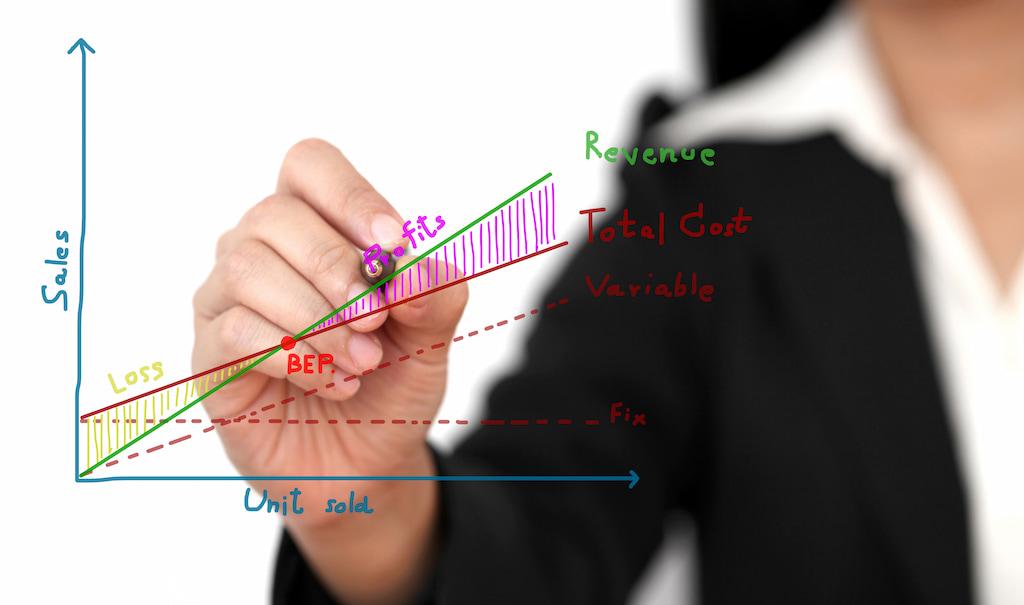Being aware of your finances is important, especially in business. Whether you’re a business owner or thinking about becoming one, you must complete a break-even analysis. This analysis will tell you the exact path you should follow to break even and make back the money you invested.
If you’ve never conducted a break-even analysis or need assistance with the process, our financial advisers are here to help!
What Is the Break-Even Point?
The break-even point, also called the BEP, refers to the revenue necessary to cover all fixed and variable expenses a business incurs. It is the point where financial losses end and profit begins. As 30% of operating small businesses are losing money, you must be planning so you can at least break even or, better yet, become profitable in the long run.
“Break-even” is a widely used term across industries, including stock and options trading to corporate budgeting. Conducting a break-even analysis allows you to outline the steps you should follow to reach profitability. Keep in mind that the profit at the break-even point is zero, and it’s only possible for small businesses to overcome this point when the sales dollar value is greater than the fixed and variable cost per unit. Nevertheless, determining your break-even point can give you insight into the metrics you must hit to profit on your fixed and variable costs.
Why Is a Break-Even Analysis Important for Your Small Business?

Even if your small business is bringing in a lot of money, you might not be making a profit. Having a sound grasp on the break-even point is important for many reasons, some of which we have outlined below.
Make Smarter Decisions
It’s easy for businesses to make decisions based on emotions. Even though it’s important to factor in how you feel, at the end of the day, remember that you’re running a business. Don’t let emotions creep into your business decisions. A break-even analysis helps you look at the bigger business picture using facts, not emotions.
Make Your Pricing Smarter
By understanding your break-even calculation, you will get clear direction on how to price your products for the fastest return on investment. Even though a significant amount of psychology goes into pricing, you must understand how the pricing will impact your profitability. This is especially true when ensuring you can cover your bills.
Determine Missing Expenses
If a new business idea comes down the pipeline, you might not consider how it will impact your expenses. Simply referring back to your break-even analysis gives you a better understanding of your various financial commitments and reduces any future surprises.
Set Revenue Targets More Precisely
Sales revenue targets act as your guiding light as a business owner. Once you’ve completed the analysis, you’ll understand exactly how much your sales team needs to sell for your company to be profitable. Then, with a precise number in mind, you can help motivate your sales team and give them additional purpose in their roles.
Reduce Financial Strain

Even if you want to jump at every new business idea, it might not be in your best financial interest. Running a break-even analysis helps your company avoid pitfalls while minimizing the financial toll of a bad idea as it realistically analyzes the different outcomes.
Fund Your Business
In many cases, the break-even analysis is necessary for investors to fund your business. It helps to prove that your plan is viable and can help you gain financing that isn’t otherwise available.
How to Calculate the Break-Even Point
First, Understand Your Data
The first step in determining your break-even point is to compile all of your company’s data. This includes how much your product costs, rent, bank fees, etc. Next, consider everything you need to pay for and write it down. The next step is to divide these costs into fixed and variable costs.
1. Fixed Costs
Any costs that remain the same regardless of how much product you sell are referred to as fixed costs. Fixed costs include insurance, rent, labor, software subscriptions, etc. List out what you pay for on a monthly basis, no matter what. In most situations, you can list total expenses in a monthly amount and add the numbers.
2. Variable Costs
Variable costs change based on how much product you sell. Examples of variable costs include payment processing, commissions, and materials. Some costs can either be viewed as fixed costs or variable costs, depending on the type of business that you run. For example, if you have salaried staff, this would be a fixed cost. Hourly employees, on the other hand, are considered variable costs. Put together a list of the costs that change based on how much you sell. Write the price per unit sold and add the costs.
3. Average Price
Last but not least, you’ll want to decide on a price. Even if you aren’t ready to commit to a final price, it’s important to establish one now. You can change it later on. Remember that this is an average price; if you offer bulk discounts for customers, it will reduce the average price.
Calculate the Break-Even Point by Units

Another way to determine the break-even point is by the number of units that must be produced to transition sales from a loss to a profit. To determine this, follow the below formula:
Break-even point (units) = fixed cost / (revenue per unit – variable cost per unit)
This formula will show how many units you must sell to cover your monthly costs. If the above formula tells you that you need to sell 50 units, for example, any units after 50 would result in a profit. On the other hand, if you don’t sell 50 units, your business will lose money.
Calculate the Break-Even Point by Dollars
You’ll want to determine your break-even point in a dollar amount at a certain point. This means you’ll have to achieve a dollar amount in terms of revenue to break even. If you make additional revenue, it is profit, but if you don’t hit that target, you’ll lose money.
To determine your break-even point by dollars, follow the below formula:
Break-even point in dollars = sales price per unit x break-even point in units
Use these formulas to compare varying strategies when pricing a product. For example, in the case that you raise the price, you’ll need to sell fewer items, but it could be more difficult to attract buyers. On the other hand, if you lower the unit price, you’ll need to sell more volume to break even.
Break-Even Point Analysis Example for Small Businesses
One of the easiest ways to understand the importance of break-even analysis is by seeing an example. Let’s say that you’re considering starting a shoe manufacturing company, and the first unit you will sell is a pair of running sneakers. Let’s determine how many shoes you need to sell to break even.
If it costs $50 to make a pair of shoes and your fixed costs are $1,000, how many pairs of shoes you need to sell depends on the price. If you sell a pair of shoes for $100, you’ll take $1,000/($100-$50) = 20 pairs of shoes. This means you’ll need to sell 20 pairs of shoes to break even; any additional pairs will profit, while fewer pairs will result in a financial loss.
If you sell a pair of shoes for $200, you’ll take $1,000/($200-$50) = 6.7 pairs of shoes. This example demonstrates that selling a product for a higher price allows you to reach your break-even point significantly faster. Before you price your shoes for $200 per pair, however, consider what your competitors are charging and whether or not you are within the same ballpark.
When to Use a Break-Even Analysis for Your Small Business?

Generally speaking, there are four business scenarios that are best served with a break-even analysis. We’ve outlined additional details below.
1. Launching a New Business
New business owners should embrace break-even analysis with open arms. Not only will this help new business owners decide if they have a viable idea, but it also forces them to do the required research and be realistic about cost pricing. Thinking through the pricing strategy is integral to long-term business success.
2. Creating a New Product or Providing a New Service
Always conduct a break-even analysis before you commit to producing a new product, especially if that product will require significant expenses. Despite your fixed costs, such as office leases remaining the same, it’s important to determine the variable costs related to your new product and determine them before the new product goes live.
3. Adding a New Sales Channel
If you’re adding a new sales channel, your costs will undoubtedly change even if your prices remain the same. Let’s say you’ve been only selling online but are thinking about opening a brick-and-mortar shop and want to ensure that you break even. If not, the new shop’s financial strain could threaten your company’s financial state.
This also applies to adding online sales channels, such as creating shoppable posts on Instagram. If you spend more money promoting the channel, such as on Instagram ads, you’ll want to include these costs in your analysis.
4. Changing Your Business Model
You might not stick with the same business model. You might not stick with the same business model forever. You might not stick with the same business model. Always conduct a break-even analysis to determine if you need to change your prices.
Tips to Lower Your Break-Even Point

After conducting this analysis, you might determine that the number of units you must sell is too high. Don’t panic! It is still possible to make adjustments to reduce this break-even point.
1. Reduce Fixed Costs
There may be an opportunity to reduce your fixed costs. If you can do so, you’ll need to sell fewer units before you break even. For example, if the retail store you’re planning to open isn’t working out in numbers, you can transition to online sales instead. This will impact your fixed costs.
2. Reduce Variable Costs
This is the most difficult option, especially for new business owners. However, if you are already on track to scale, it could be easier to reduce your variable costs. Try negotiating with your suppliers, changing suppliers altogether, or changing your process. For example, you could determine that packing peanuts is cheaper than bubble wrap.
3. Increase Your Prices
As we determined, raising your prices means that you won’t need to sell as many units to break even because the marginal contribution per unit sold is higher. If you are considering this approach, always do your research to see what the market reflects. Even though you won’t need to sell as many units, you need to be mindful of what buyers are willing to spend.
Is Conducting a Break-Even Analysis Always a Good Idea?
While there are plenty of benefits to this analysis, there are some limitations:
- This analysis focuses on the supply side of your business; it doesn’t reflect what your sales are likely to be for the product at different price points.
- If you increase the production scale, it could result in higher fixed costs.
- It assumes that the average variable costs are steady per unit of output as well as per the range of the sales numbers.
- If you offer multiple products, the relative proportions of each sold product are either fixed or constant.
- It assumes that how many goods you produce equals how many goods you sell. This means there is no change in how many goods are held in inventory at the beginning and end periods.
Conclusion
As a key takeaway, remember that a break-even analysis is only as reliable as the underlying assumptions. Conducting this analysis has benefits as it outlines the framework you’ll need for pricing, employees, operations, and future support. If you need additional support in this process, our team at Cultivate Advisors is happy to assist you! Schedule an initial phone call with our team today.



